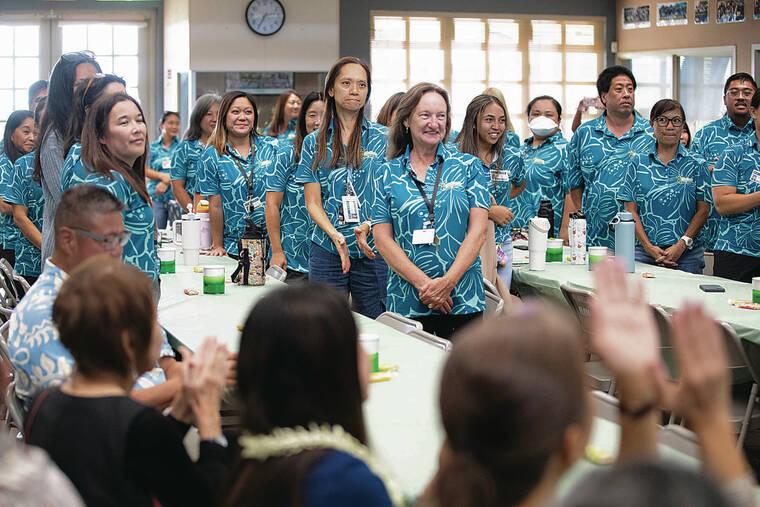Three Hawaii public schools have received top national honors for their work in career- connected education — part of the state’s efforts to integrate college and career readiness from elementary through high school.
At the National Career Academy Coalition (NCAC) conference held in October, Waikele Elementary School, Kohala High School and Waipahu High School were recognized. Waikele Elementary School made history as the first elementary school in the nation to earn NCAC’s prestigious “Model Academy with Distinction” designation — the coalition’s highest honor, awarded to schools that meet or exceed proficiency in all ten national standards of practice.
The recognition highlights Hawaii’s growing leadership in career academy education. Educators said the awards reflect a milestone for Hawaii public education, showing how career academies — once limited to high schools — now span preschool through adulthood. The state now has 26 high schools with model academies, including 20 “Wall-to-Wall” schools where every student participates in a nationally recognized academy.
Waikele’s Academy Pathway program is a cornerstone of the Waipahu Complex pipeline, offering hands-on experiences in career exploration from a young age. It was the first elementary school in Hawaii to fully integrate career and technical education into its school design.
Sheldon Oshio, Waikele Elementary principal, emphasized the importance of alignment across elementary, intermediate and high schools, and said that at Waikele, students begin career awareness early.
“Our students take multiple self-awareness assessments,” Oshio said, adding that they have the opportunity to attend an annual career and college fair in the fourth quarter, which prepares them to begin the academy program in the second quarter.
Don’t miss out on what’s happening!
Stay in touch with breaking news, as it happens, conveniently in your email inbox. It’s FREE!
Waikele’s curriculum includes courses typically reserved for older students — from culinary arts and woodworking to electrical circuitry — covering all six career and technical education pathways.
The school’s multi-age structure promotes collaboration. Students are grouped from preschool through sixth grade, pre-K to second grade, and third to sixth grade.
Oshio said the NCAC recognition “is a strong validation of the national standards of practice” and “a great validation of our collective work.”
Waipahu High School also received national acclaim for leading the country in academy programs. It was awarded NCAC’s inaugural North Star Award for providing guidance and inspiration to students and the community.
Waipahu High School Principal Zachary Sheets said its Ohana Academy of Excellence was designed to take an inclusive approach to career education.
Sheets said that the academy serves students on a certificate track, offering them the same work-based learning opportunities as diploma-bound students.
“It was created to honor their unique needs and provide them with the same level of work-based learning opportunities that our other students are afforded,” he said.
Sheets praised the teachers and academy leadership for fostering teamwork, emphasizing that success depends on collaboration among staff, families and industry partners.
Last year, he said 12 of the academy’s certificated students earned early college credit from Windward Community College, showing that college is achievable for everyone.
Students in the program begin with roles in food service where they learn to communicate, handle funds, and take orders, before progressing to running the student-operated campus’s cafe. “Eventually they’ll go to an internship, maybe at McDonald’s, and hopefully that employer provides them employment,” Sheets said.
He added, “For these students, it’s really about their independent skills, ensuring they can communicate, take care of themselves. We give them financial classes, because they’re earning checks.”
On Hawaii island, Kohala High School became the first small, rural high school in the country to earn NCAC Model Academy designation. With just 260 students, the school offers four career pathways — Natural Resources-Food Systems, Construction, Health-Nursing and Culinary. The aim of the pathways, which are supported by dedicated teams and community partners, is to embed entrepreneurial skills.
Kohala High’s academy lead Dean Snelling, recipient of NCAC’s John Thompson Exemplary Educator Award, said the model has revitalized the school’s approach to education.
“NCAC has been used by schools in Hawaii to start using what was previously called vocational education, which took a backseat for a while,” Snelling said. “It’s re-emerging as a tool used to get school kids excited about education.”
Students choose from natural resources, food production, construction, nursing or culinary arts. They remain with the same teacher throughout high school, and complete a senior-year capstone project.
Snelling emphasized that that the program seeks to engage students by leveraging their personal interests and backgrounds in hands-on or career technical education.
“Titles are nice,” he said, but added,”to me it’s more important to focus on what the students are getting out of it.”
Snelling said some of the students bought into the program faster than the teachers, and quickly caught on to the new integrated career-building structure.
“Every time you place opportunities in front of kids, 99% of the time they take it and exceed your expectations,” he said.
Hawaii Schools Earn Recognition
2025 NCAC Model Academies with Distinction:
>> James B. Castle High School’s Freshman Academy
>> Kapolei High School’s Hoʻola Natural Resources Academy
>> Waipahu High School’s ‘Ohana Academy of Excellence
>> Waikele Elementary School’s Waikele Pre-Academy
2025 NCAC Model Academies:
>> Hilo High School’s Freshmen Academy
>> Kapolei High School’s Business Academy, Engineering, Design & Energy Academy
>> Kohala High School’s Academy of Sustainability
>> Waiakea High School’s Arts and Communication, Academy of Industry and Technology
>> Waipahu High School’s Academy of Arts and Communication

